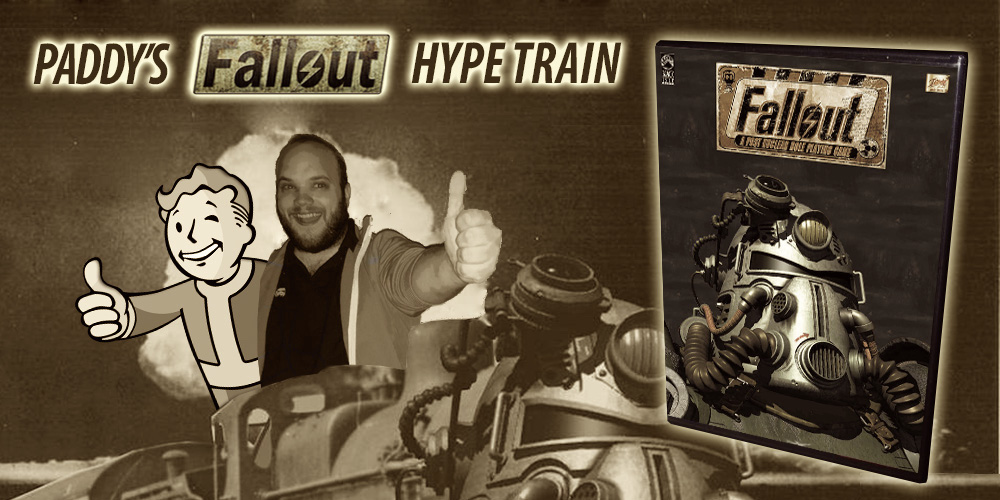
ATTENTION READER, SPOILERS!: This is part 2 of an ongoing series of articles, click here for the first in the series. I won’t be going out of my way to spoil major plot details, however, due to the nature of these articles, some details are going to be discussed. You have been warned.
In the last entry of this series, I ventured half-cocked into the Californian wastes of Fallout 1 and died a bunch in hilarious ways. CrunkKing69 and HELK were like sons to me, stupid, brash and violent sons that died as they lived: Under the control of someone with little regard for their lives. As fun as it is to drive my fists into the inhabitants of the wasteland until they riddle me with bullets, it’s for that same reason that I reassessed my tactics. Re-rolling a new character, I ventured forth into the wastes for my third playthrough as “Danger Dan, the Wanderer of Questionable Skill.” Join me in learning what the world of Fallout is like when you play without a death wish.
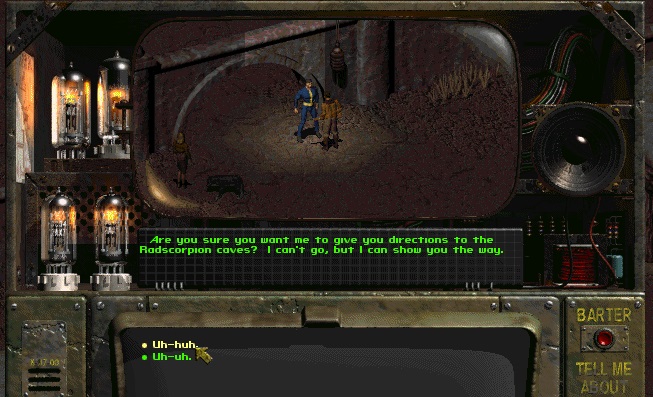
And with an INT above 2.
1997 was a good year for gaming (seriously, check out that list of titles) and Fallout was no small contributor to that. By many accounts, the game was incredibly well received at the time of release (enough to spawn the franchise that it has) and remains a cherished classic to this day. Fallout in its entirety almost never happened; the creators, Interplay, wanted to make a sequel to the 1988 title Wasteland but were unable to obtain the license rights from EA. Had EA not been a pack of greedy dicks and played nice with others in the industry I might not have been able to write this at all. Thanks EA – never thought I’d say that.
Given the time that Fallout was released, I can see why it became so popular. Many RPG’s being released around the same time followed something more of a linear story progression and had nothing like the kind of world exploration present in Fallout. Even by the standards of most games these days the world of Fallout is huge, covering a decent chunk of the US’ south-west. There’s also a lot of freedom (albeit sometimes strained) to play your character the way you want to play them for a game of its time, whether you want to play the strong, quiet, Mad Maxian protagonist or… Something else. Where I think the game excels the most is how it combines the large amount of content with the imposed time limit of the main storyline to create a huge amount of replayability.

I mean, Junktown’s no Megaton but there’s still a lot of fun to be had if you stab the right people.
The game starts out with the player being informed by the Overseer of Vault 13 that their water purification chip is kaput, and you’ve all got about 150 days before you start dying of thirst. He instructs you to leave the vault and find a new chip, all the while remaining mindful of the ever-present countdown to doomsday. That’s a fairly short amount of time and while I won’t go into how or why, that time limit can be increased to 500 days. Even with that increase, I’d wager it would be damn near impossible to explore everywhere and do everything in a single playthrough. Add in branching paths and multiple outcomes for both the main and side quests, and this is the kind of design that has the potential to get players back for a second playthrough. And a fifth. You stop counting after awhile.
Seeing the game in action – how it looks, how it plays, and the lack of certain mechanics if you’ve played later titles in the series – is where it shows its age. This game is hard and make no mistake; there’s a learning curve to making the character building system work for you and even then just surviving in the beginning can be a challenge. The SPECIAL system covers your average RPG areas of character building: Strength, Perception, Endurance, Charisma, Intelligence, Agility, and Luck. Theoretically, this would let you play the game in almost any way you’d want but the game’s difficulty kind of precludes most play styles that aren’t “psychotic death machine.”

Every time, just to be safe.
There’s no way to reduce the number of random encounters outside of having a high Luck stat; that skill wouldn’t be introduced until the second game. Trying to do a no-kill or non-violent playthrough of the first Fallout game would be insanely difficult for this fact alone with the amount that you go through while getting around. You’ll want to make sure that your character can move pretty fast because, without a decent number of points in your chosen combat skill, you’re not hitting squat. At least for the first few playthroughs or until you learn about certain game progression points, you’ll want a character who can take and deal out a few hits. If it sounds like I’m making an unnecessary fuss about the difficulty of the game it’s because this is hands down the hardest in the series.
Enemies in this game are more than hardy; even Molerats can pose a significant risk at the beginning of the game if you’re not careful. Running into a pack of Raiders is enough to make you pack your pants, and followers are glorified meatshields-slash-decoys in the heat of a random encounter. Save scumming is basically your only way to progress if you’re new to the game, and you’ll still want to be frequently saving even if you know what you’re doing. Whether or not this is a criticism depends entirely on your perspective, since games that are almost prohibitively difficult to new players isn’t exactly a deterrent for some. It does, however, make role-playing a character with certain personality traits – such as passivity, or brains-over-brawn – much more difficult. Personally, while I enjoy the combat system and the way it forces you to consider how you approach each fight carefully, I also think it sucks that playing HELK is so difficult.
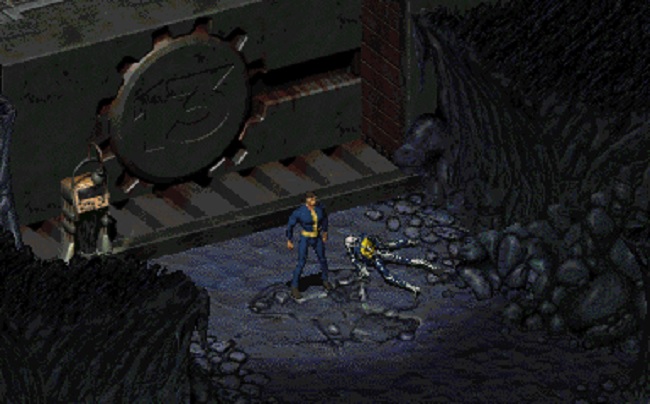
The big, lovably violent luggamajug.
Unlike later entries in the series, the first game was an apocalyptic wasteland at its core with just smatterings of olden days America here and there. You might be thinking, “Well, no shit – that’s exactly what all of them are like,” but let me compare this game to Fallout 3 and explain what I mean. The buildings are largely rubble and ruin in Fallout 3, sure, and that’s in the few places that you can even find buildings. When you do find them, however, they usually clearly retain the appearance and architectural style from when they were built and that style is based on 1950’s Americana. The Fall didn’t really stop the people of the Capital Wasteland from living their lives the way they always had. (As a collective, I mean, I’m sure it stopped individual people plenty well.) They’re a bit fuzzy on some details of the past, sure, but they still pursue the same ideals, live in the same buildings and, sometimes, literally eat the same food. Like, right off the shelf as though it were bought yesterday and hadn’t been sitting there for a century and a half.
In the original Fallout, however, the wasteland is very much the basis for the world before anything else. The entire map is completely blighted with arid desert filling out most of the landscape, and old cities or towns are a rarity. Most of the structures that you’ll find are tents, shacks, and shanties cobbled together from loose bits of corrugated steel, wooden beams and whatever else was handy at the time. Nicer settlements, like Shady Sands, for instance, will have buildings that appear to be made from stone or a crude cement or maybe they’ll be properly reinforced with steel and brick. Maybe. Those are usually owned by the kind of people willing to do shitty things to afford them. Any buildings that have survived the Great War, however, always look to have been ruined, scorched, crumbled or otherwise made near uninhabitable. They’re reserved for ghouls, outcasts, scavengers or those who have no other choice but to live there.

Mmmmmmm. 200 year old Fancy Lad Cakes. Delightful and not at all likely to kill me upon ingestion.
The “1950’s” vibe in Fallout wasn’t initially supposed to come from such a direct connection to that period of American history or, at least, that’s the way I see things. It was supposed to be in the “retro sci-fi” interpretation of what a world like that might be like, seen through the eyes and imagination of someone who read pulp magazines on the regular. Clunky robots with flailing arms and miraculous though still distinctly stupid AI. Computers that look like boxes, which are only capable of outputting text, and are thought of as marvels of science. Plasma weapons and literal alien ray guns that melt or disintegrate their targets respectively. The vaults are a combination of this retro sci-fi theme and cold war era alarmism, taken to its logical conclusion point, and used as the basis for an entire world.
How that all appears visually is a different story altogether since this is a game from 1997, after all, and nothing is immune to the ravages of time – especially late 90’s CGI. As mentioned, Fallout still maintains an undeniable visual style that’s present in everything from the HUD to the costume design (as limited as that is in this game.) How objects are presented graphically, however, isn’t always the most practical. It can be difficult to pick out important objects from the terrain and even things like landing your cursor on ladders can be a mission. Finding items that are lying around on the ground is almost impossible as they blend into the terrain. Important or useful objects don’t stand out or aren’t always, even though they really probably should.
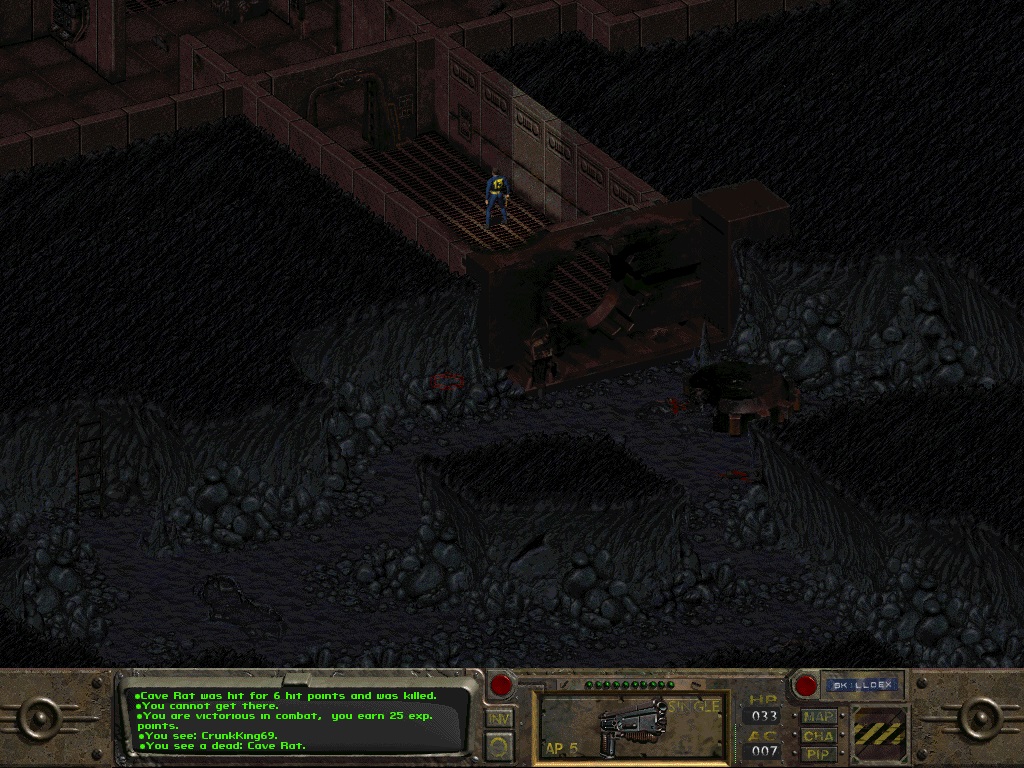
Somewhere in that cave is a blue-ish/grey box of ammo. Have fun.
That being said, it could be a lot worse, and these certainly aren’t the worst graphics I’ve ever seen for a game of this period. You would certainly hope so, too, considering that a large portion of the development team were artists. Aside from some very poop-like Molerats, the creatures of the Wasteland are fairly well designed, easily distinguishable, and actually resemble what they’re supposed to be. Buildings and terrain, while sometimes difficult to navigate, are still well-crafted and collectively form a varied landscape. It is, of course, a little rough around the edges, but it’s an impressive achievement for any game of eighteen years to not melt the eyes of future players with it’s terrible graphics.
Surprisingly, the game features FMV cutscenes, and the most important characters are fully voiced with their character portraits animated to appear as though they’re talking to you. Interplay even got celebrities to do some of the voice acting before that was the standard thing to do! Among them was Ron Perlman as the narrator, Tony Jay as the Mutant Lieutenant*, and Richard Dean Anderson as Killian Darkwater – that’s motherfucking McGuyver man! If I were the kind of person who even remotely cared about Richard Dean Anderson and had been playing this game at the time of release, that would have blown my god damn mind. It even kind of looks like him, too – see for yourself:
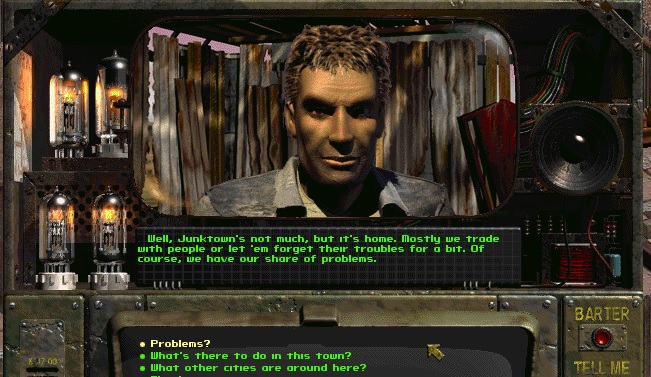
Soak in that pre-Cheeseburger ridden Richard Dean Anderson charm, in all it’s pre-rendered glory!
I wouldn’t venture to rate Fallout against the rest of the games in the series, though if it were to be the “est” of anything it would definitely be the hardest. Whether due to the ridiculously difficult combat or the aged graphics, an easy time will certainly not be had by all. This is the game that set the scene for the rest of the series, however, and did so with finesse. Fallout is arguably the quintessential post-apocalypse videogame and a big part of that is the style and charm that it carries. That style may not be as prevalent in this game as it is in others though it’s fair to say that it was certainly something in it’s time. And as for Danger Dan? Well, some say he’s still out there, wandering the wastes in search of the Water Chip. Others reckon that he took up with the mutants and traded in his old life for a new, uglier one. One thing’s for sure, though…
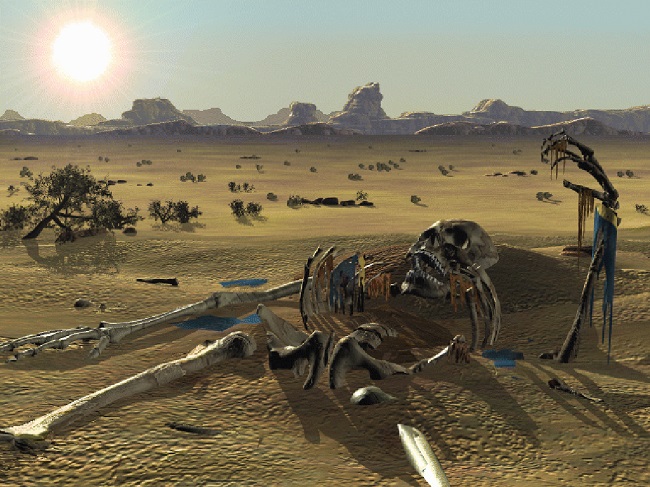
He is absolutely dead.
*If you’re anything like me, you’d likely care more about Tony Jay’s role as Megabyte from the classic series ReBoot over MacGuyver. He even uses practically the same voice for the role of the Mutant Lieutenant (warning – major spoilers.)











